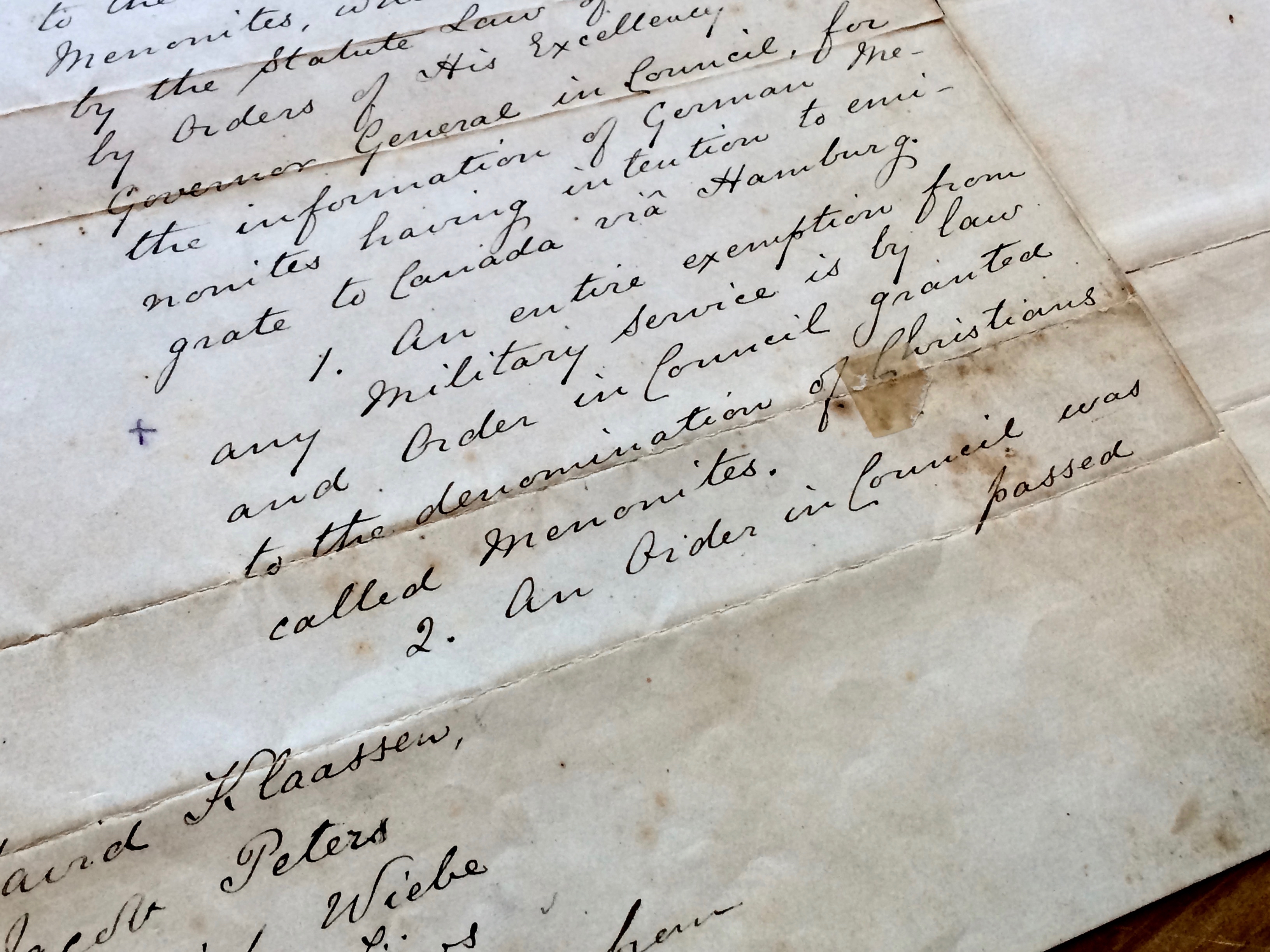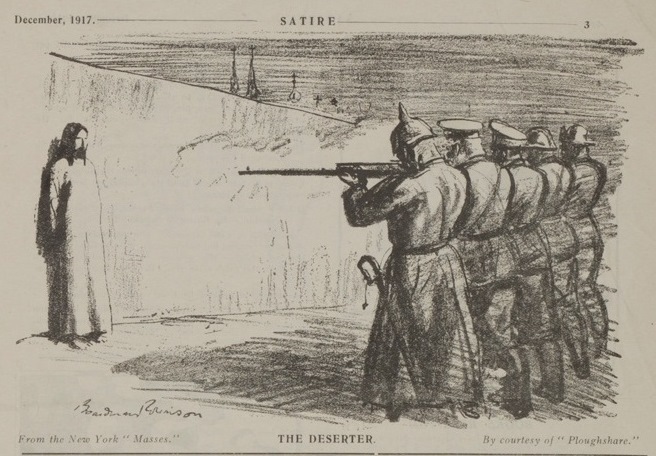|
Privilegium Of 1873 (Canada)
The Privilegium of 1873 (sometimes called "The Lowe Letter") is the original invitation letter from the Dominion of Canada to Mennonites living in the Russian Empire offering them land, military exemption, and private schools, among other privileges. Because of their pacifist beliefs, Mennonites were known to migrate to other countries in order to maintain their lifestyles. When migrating, they signed agreements with their host countries. These agreements were known as Privilegium or "Privileges." A similar Privilegium had been signed with Catherine the Great of Russia when Mennonites first immigrated from Prussia to the Russian Empire in the 1770s. In 1873, twelve Mennonite delegates from southern Russia set out to North America to investigate new lands. Of the 12 delegates, four decided to accept Canada's offer of land in the newly formed province of Manitoba. Representatives of the Bergthaler and Kleine Gemeinde churches, David Klassen, Jacob Peters, Heinrich Wiebe, and Cornel ... [...More Info...] [...Related Items...] OR: [Wikipedia] [Google] [Baidu] |
West Reserve
The West Reserve was a block settlement plot of land in Manitoba set aside by the Government of Canada exclusively for settlement by Russian Mennonite settlers in 1876. After signing Treaty 1 with the Anishinabe and Swampy Cree First Nations, the Canadian government sent William Hespeler to recruit Mennonite farmers to the region. In 1873 Mennonite delegates from the Russian Empire, (David Klassen, Jacob Peters, Heinrich Wiebe, and Cornelius Toews), visited the area and agreed to a Privilegium outlining religious freedom, military exemption, and land. This land became known as the East Reserve, because it was east of the Red River. After two years, however, it was determined that the land of East Reserve was limited and unsuitable for farming, so a second larger reserve on the west side of the Red River was established in 1876. This land became known as the West Reserve. Many of the Mennonite settlers of the West Reserve stayed at Fort Dufferin before venturing out to establish v ... [...More Info...] [...Related Items...] OR: [Wikipedia] [Google] [Baidu] |
Winnipeg
Winnipeg () is the capital and largest city of the province of Manitoba in Canada. It is centred on the confluence of the Red and Assiniboine rivers, near the longitudinal centre of North America. , Winnipeg had a city population of 749,607 and a metropolitan population of 834,678, making it the sixth-largest city, and eighth-largest metropolitan area in Canada. The city is named after the nearby Lake Winnipeg; the name comes from the Western Cree words for "muddy water" - “winipīhk”. The region was a trading centre for Indigenous peoples long before the arrival of Europeans; it is the traditional territory of the Anishinabe (Ojibway), Ininew (Cree), Oji-Cree, Dene, and Dakota, and is the birthplace of the Métis Nation. French traders built the first fort on the site in 1738. A settlement was later founded by the Selkirk settlers of the Red River Colony in 1812, the nucleus of which was incorporated as the City of Winnipeg in 1873. Being far inland, the local ... [...More Info...] [...Related Items...] OR: [Wikipedia] [Google] [Baidu] |
Canadian Mennonite University
Canadian Mennonite University (CMU) is a private Mennonite university located in Winnipeg, Manitoba, Canada, with an enrollment of 1607 students. The university was chartered in 1999 with a Shaftesbury campus in southwest Winnipeg, as well as Menno Simons College and a campus at The University of Winnipeg. History Canadian Mennonite University was incorporated in 1999, through the amalgamation of Canadian Mennonite Bible College (founded in 1947), Concord College (founded as Mennonite Brethren Bible College in 1944), and Menno Simons College (founded in 1988). A fourth college, Steinbach Bible College, was also involved, but later withdrew. The name, Canadian Mennonite University, was formally announced in early 2000 and classes began in September of that year on a new campus, composed of the campus of Canadian Mennonite Bible College on the south-west corner of Grant and Shaftesbury and the former campus of the Manitoba School for the Deaf. In 2009, Canadian Mennonite Univers ... [...More Info...] [...Related Items...] OR: [Wikipedia] [Google] [Baidu] |
Steinbach, Manitoba
Steinbach () ( Plautdietsch: /ˈʃte̞nbah/ or /ˈʃte̞nbax/) is a city located about south-east of Winnipeg, Manitoba, Canada. Steinbach is the third-largest city in Manitoba, with a population of 17,806, and the largest community in the Eastman region. The city is bordered by the Rural Municipality of Hanover to the north, west, and south, and the Rural Municipality of La Broquerie to the east. Steinbach was first settled by Plautdietsch-speaking Mennonites from the Russian Empire in 1874, whose descendants continue to have a significant presence in the city today. Steinbach is found on the eastern edge of the Canadian Prairies, while Sandilands Provincial Forest is a short distance east of the city. Steinbach's economy has traditionally been focused around agriculture; however, as the regional economic hub of southeastern Manitoba, Steinbach now has a trading area population of about 50,000 people and significant employment in the financial services industry, au ... [...More Info...] [...Related Items...] OR: [Wikipedia] [Google] [Baidu] |
Christian Mennonite Conference
The Christian Mennonite Conference, formerly known as the ''Chortitzer Mennonite Conference'' (german: Die Mennonitische Gemeinde zu Chortitz), is a small body of Mennonites in western Canada. History The forerunners of this group came to Manitoba from Russia in 1874. They were first known as Bergthalers, but eventually became known as ''the Chortitzer Church'' because their bishop, Gerhard Wiebe (1827-1900), lived near the village of Chortitz (now known as Randolph), and made the local church his home church. This group was very conservative. They sang without harmony (parts), restricting the singing to a melody only. They allowed neither Sunday schools nor evening services. The German language was used exclusively in church services. The bishop and ministers possessed most of the authority in the conference, allowing for little local autonomy. The departure of the more conservative families to Paraguay in 1948 left the more progressive families remaining in Canada. This ... [...More Info...] [...Related Items...] OR: [Wikipedia] [Google] [Baidu] |
World War II
World War II or the Second World War, often abbreviated as WWII or WW2, was a world war that lasted from 1939 to 1945. It involved the World War II by country, vast majority of the world's countries—including all of the great powers—forming two opposing military alliances: the Allies of World War II, Allies and the Axis powers. World War II was a total war that directly involved more than 100 million Military personnel, personnel from more than 30 countries. The major participants in the war threw their entire economic, industrial, and scientific capabilities behind the war effort, blurring the distinction between civilian and military resources. Air warfare of World War II, Aircraft played a major role in the conflict, enabling the strategic bombing of population centres and deploying the Atomic bombings of Hiroshima and Nagasaki, only two nuclear weapons ever used in war. World War II was by far the List of wars by death toll, deadliest conflict in hu ... [...More Info...] [...Related Items...] OR: [Wikipedia] [Google] [Baidu] |
World War I
World War I (28 July 1914 11 November 1918), often abbreviated as WWI, was List of wars and anthropogenic disasters by death toll, one of the deadliest global conflicts in history. Belligerents included much of Europe, the Russian Empire, the United States, and the Ottoman Empire, with fighting occurring throughout Europe, the Middle East, Africa, the Pacific Ocean, Pacific, and parts of Asia. An estimated 9 million soldiers were killed in combat, plus another 23 million wounded, while 5 million civilians died as a result of military action, hunger, and disease. Millions more died in Genocides in history (World War I through World War II), genocides within the Ottoman Empire and in the Spanish flu, 1918 influenza pandemic, which was exacerbated by the movement of combatants during the war. Prior to 1914, the European great powers were divided between the Triple Entente (comprising French Third Republic, France, Russia, and British Empire, Britain) and the Triple A ... [...More Info...] [...Related Items...] OR: [Wikipedia] [Google] [Baidu] |
Conscientious Objectors
A conscientious objector (often shortened to conchie) is an "individual who has claimed the right to refuse to perform military service" on the grounds of freedom of thought, conscience, or religion. The term has also been extended to objecting to working for the military–industrial complex due to a crisis of conscience. In some countries, conscientious objectors are assigned to an alternative civilian service as a substitute for conscription or military service. A number of organizations around the world celebrate the principle on May 15 as International Conscientious Objection Day. On March 8, 1995, the United Nations Commission on Human Rights resolution 1995/83 stated that "persons performing military service should not be excluded from the right to have conscientious objections to military service". This was re-affirmed on April 22, 1998, when resolution 1998/77 recognized that "persons lreadyperforming military service may ''develop'' conscientious objections". H ... [...More Info...] [...Related Items...] OR: [Wikipedia] [Google] [Baidu] |
East Reserve
The East Reserve was a block settlement in Manitoba set aside by the Government of Canada exclusively for settlement by Russian Mennonite settlers in 1873 (although settlement did not occur until 1874). Most of the East Reserve's earliest settlers were from the Kleine Gemeinde or Bergthaler Mennonite churches. After signing Treaty 1 with the Anishinabe and Swampy Cree First Nations in 1871, the Canadian government sent William Hespeler to Russia to recruit Mennonite farmers to the region. The first Mennonites to visit the area in 1872 were Bernhard Warkentin and Jacob Yost Shantz, a Swiss Mennonite from Ontario, who wrote a ''Narrative of a journey to Manitoba'', a report which helped convince Russian Mennonites to move to the area. In 1873 twelve Mennonite delegates from the Russian Empire, toured Manitoba and Kansas. The group looked at various locations in Manitoba, including the western part of the province, but chose the East Reserve because of its proximity to Winnipeg. De ... [...More Info...] [...Related Items...] OR: [Wikipedia] [Google] [Baidu] |
Canada
Canada is a country in North America. Its ten provinces and three territories extend from the Atlantic Ocean to the Pacific Ocean and northward into the Arctic Ocean, covering over , making it the world's second-largest country by total area. Its southern and western border with the United States, stretching , is the world's longest binational land border. Canada's capital is Ottawa, and its three largest metropolitan areas are Toronto, Montreal, and Vancouver. Indigenous peoples have continuously inhabited what is now Canada for thousands of years. Beginning in the 16th century, British and French expeditions explored and later settled along the Atlantic coast. As a consequence of various armed conflicts, France ceded nearly all of its colonies in North America in 1763. In 1867, with the union of three British North American colonies through Confederation, Canada was formed as a federal dominion of four provinces. This began an accretion of provinces and ... [...More Info...] [...Related Items...] OR: [Wikipedia] [Google] [Baidu] |
Kleine Gemeinde
Kleine Gemeinde is a Mennonite denomination founded in 1812 by Klaas Reimer in the Russian Empire. The current group primarily consists of Plautdietsch-speaking Russian Mennonites in Belize, Mexico and Bolivia, as well as a small presence in Canada and the United States. In 2015 it had some 5,400 baptized members. Most of its Canadian congregations diverged from the others over the latter half of the 20th century and are now called the Evangelical Mennonite Conference. History The Kleine Gemeinde was founded in 1812 by a small group of Mennonites dissatisfied with the state of the existing church in the Molotschna colony settlement of then south Russia (present-day Ukraine). Their first elder was Klaas Reimer. The name ''Kleine Gemeinde'' means Small Church, or congregation. The group changed their name from Kleine Gemeinde to Evangelical Mennonite Church in 1952, and to Evangelical Mennonite Conference in 1959. Klaas Reimer Klaas Reimer (1770–1837), a Mennonite minister ... [...More Info...] [...Related Items...] OR: [Wikipedia] [Google] [Baidu] |


.png)



